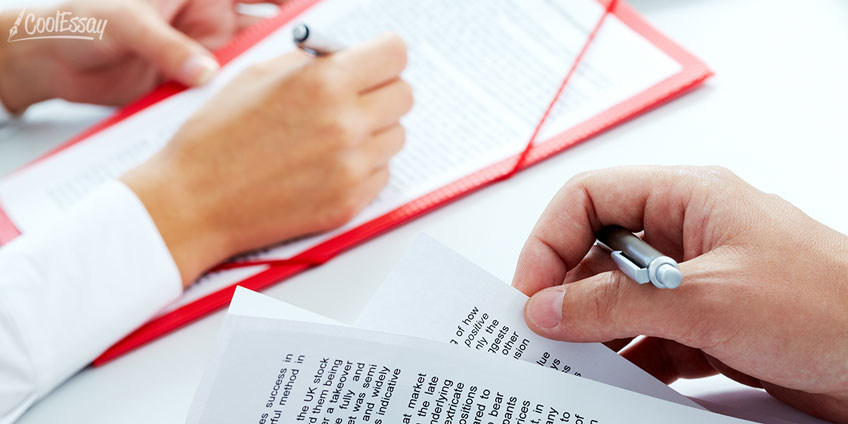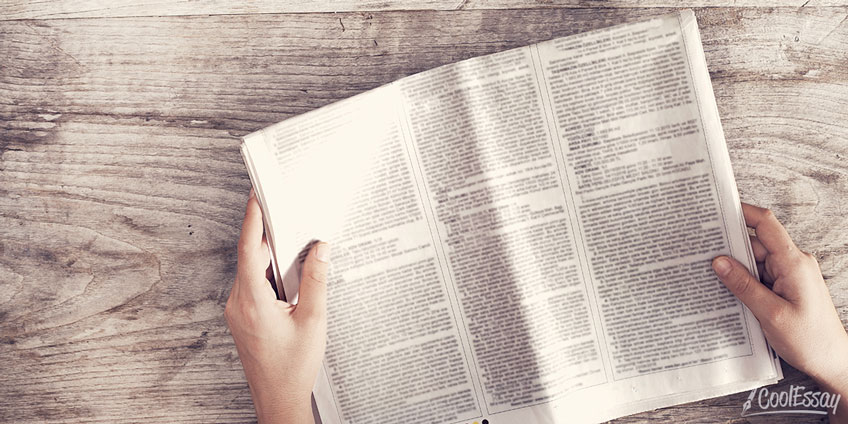
A research article, a review article, a newspaper article. There are a lot of different types of papers that our teachers ask us to write. Now I am going to give you the best tips and the main points on how to deal with each type of the article, so you do not have to struggle with difficult assignments anymore.
Tips on How to Write Any Article
These basic principles always help me to understand whether I wrote a good paper or not. You can learn how to write a great article too.
Title
Keep the title short (up to 7 words). As soon as it gets too long, people get bored reading the title, so they are definitely not going to read the whole article. You should not have a fully complete grammatical sentence, just keep your keywords and keep it relevant. In other words, when I read the title, I should already have an idea what article is about. Capture the main idea and make it interesting. For example, the title “Music, moods and memories” has only three nouns and a conjunction, but it grabs the reader’s attention.
Remember, numbers always work. People like to see numbers because that’s how they know exactly how long they’ve got to focus. They can figure that if the title is “7 steps to deal with stress,” “3 ways of preventing the war,” or “4 reasons for imperialism,” it’ll take approximately 7, 3 or 4 minutes to read it.
Introduction, Paragraphs and Conclusion
Starting your article with a question is always a good idea. It will draw the reader into the story. For example, have you ever listened to a sad song and ended up smiling for no reason? It is because of the music’s power to instantly send you back in time.Doing that, you immediately make it clear that the focus of the article is music and its power.
In paragraphs, you can put tons of information, but you still need to have a general focus on the paragraph. Do not put unrelated ideas because the reader then can’t follow your train of thoughts and logic. Make it flow. You can do it in several ways by using subheadings, bullets and numbers.
Ideally, your ending, your last sentence ties back to your first sentence or to the introduction paragraph. That way you have a complete circle, and it ties all article together. But if you are tired of thinking about the structure, the first sentence and the conclusion, let the professionals deal with it by using article writing service.
The Language
The language you are using reflects what it is you are actually writing about. Do not use academic language, while you are writing for a website or a blog, be more casual in your word choice. Make sure it is quick, easy and simple, not overly complicated. Make your language idiomatic, playful, let the reader have fun with it.
Do not be afraid to use I, me, we, my, you, etc. You are addressing the reader directly. It is like you are having a conversation, but it is written instead of spoken. Do not be stiff, use “but” instead of “however,” “so” instead of “consequently” and “as a result.”
Twist and play with common expressions. For instance, let’s say you write about the French cuisine. This is an example of a word play in an introductory sentence: “I think, spices are the spice of life” instead of “They say variety is the spice of life.”
Change one word to a phrase, for example, stroll through memory lane sounds way more interesting than just the word “nostalgic.” I wallow in sad tunes instead of I sink. Try to use “colorful” adjectives. Catchy, sunny beats instead of fast ones. Fun and funky (two F) are a great fit when you describe music. Let the reader get more involved in the writing.
These are some general rules, but let’s also take a look at the most common article types.
How to Write Review Article?

A typical article review is both a summary and a logical evaluation of a writer’s article. You should understand the main points and arguments of the paper. Your main goal is to express yourself to a reader about what you think is important from the text you are reading or are exposed to.
It can be an article from any source you like. These are some of my suggestions in regards to the sources which are interesting and reliable enough. So, use Wall Street Journal, Harvard Business Review, The Fortune magazine, Business Week, the New York Times, The Economist, Entrepreneur. To be honest, teachers usually are not as interested in a journal article as in a peer-reviewed article. So, where to start?
Find something you consider interesting in your textbook and then find an article that compares or contrasts what the authors of your textbook state as a fact or as an experience. Once you figure out the topic and find a relevant article, you can use it as a way to either enhance or subtract from what is stated.
Article review should be 4 to 5 pages in length without a cover and a reference page.
Here we use a format which is pretty prescriptive.
- Cover sheet with your name, class designation, article title, and date
- The first paragraph basically introduces the article to the reader. It mentions who wrote it, when it was written, what the title is and what the article is all about. Do not get too detailed. Usually it starts with the introduction/citation of the source(s) that are analyzed and provides a summary of the article’s highlights. Discuss only important details.
- The following paragraphs is where you explain why the article is significant and how it is connected to your topic via citations. Add some linkages through citation. To direct you, I will give you some questions you need to answer in the following paragraphs: does the article add to the literature that already exists on the topic? Does the article contain any information that would be considered a “breakthrough”? Will the information contained in the article make other people in the field of discussion change their ideas about the subject matter or does it simply revisit information that is already known in the field?
All these questions should help you form your critical opinion about the article and are the basis of any article review.
Do not get bogged down in multiple article reviews. It is too cumbersome, and it takes a lot of your resources to try to make this work.
- The final paragraph or conclusion is where you need to tie things up with some sort of an evaluation. Firstly, you should mention what topic it ties to in the textbook. What chapter? Is more study required on the topic? Is it well-written or not? Is it purposeful? You can have an opinion on this, but you also need to be factual.
For this kind of paper, you need to use proper business-type language. Do not forget, when commenting on the author, use their last name after the first notation. For example, in the text written by Lily Collins, the author states – Later, Addison commented or comments.
Forget about contractions.
Another tip is to reference the article that you choose to write about as well as the textbook on a separate reference page. If there are online or e-book versions, use the special notation that your teacher will provide you.
How to Write Newspaper Article?

I suppose the first thing you read on any web page about writing a newspaper article is a phrase “plan your content.” That is why I will not repeat it. Just let me say, when you have an outline, you know the direction you are heading in. You do not have to stop and waste time trying to think about what to write next. So, what are the main steps to writing a good newspaper article?
Firstly, make sure you include a headline which grabs the reader’s attention. Avoid small words that have little meaning like “the” or “of.” You can use a pun if the article’s content is slightly more informal. If it is sort of a broadsheet article, then it can be a summary of the article itself.
To write a good introduction, use the concept of the five W’s (who, what, where, when and why). Briefly summarize what the whole story is all about. After you write the introduction, read it one more time and make sure you answered all of the five W’s in the paragraph.
Then we move to the main body. Explore the story in detail, using quotations as well as the analysis of the preceding events. Give the reader some background, so they can understand what you are talking about. Imagine you are talking to an old friend and explaining to them what has happened. Include a variety of sentence starters. “Next, next, next” is a bad idea.
Finally, in your conclusion move right away from the past tense. Briefly explain what will happen in the future regarding the story.
Once you wrote it, it is time to edit it and show off your writing ability. Add some metaphors, synonyms, beautiful phrases. Now let’s go back to the chapter where we discussed tips on how to write any article and check all the points.
How to Write Research Article?

Whether you are a PhD candidate or a first-year student, whether you need to write a newspaper article or a review article, firstly you have to research your topic. But when it comes to a research article, it can take longer to explore your theme.
What is a research article? How is it different from a review? It’s quite simple: a research article describes original study’s results, whereas in a review you write about other articles, so it does not include original research.
To write a compelling research article, you have got to come up with a topic. Start by coming up with a question you have about the field of your study. It can be broad, or it can be specific. Just make a list of questions you personally want to know the answers to. For example, what is the reason it was so hard to evacuate Dunkirk during World War II? Are robots going to populate the Earth by 2100? What is the power of artificial intelligence?
The next step is starting to narrow down. The broader the question, the harder it will be to answer. Compare the two questions – what is consciousness and what are the ways we can use our consciousness? When answering the second question, you can follow a clear-cut list of ways, while answering the first one is much harder, as it is more abstract.
Then it is time for research. Use Google Scholar, do not disregard a good old library, jot down some of the cited sources in relevant papers’ list. Start learning from the sources, try to make generalizations, take different ideas from different sources and put them together in a way that no one has thought of before.
Then you have to create a thesis based on the collected data. You goal at this stage is to get something super basic. Once you have got a functional baseline, you can get creative.
The next step is starting to write an outline. Look at papers related to your thesis and see what kind of subsections they include. Create a generalized list of subsections from the related papers. It will be your first draft. All you need to do after is to read it, then read it one more time and read it again.
Generally, your research article should start with a title and an abstract which summarizes your work. The next step is introduction with your motivations and the background data. Body paragraphs document your research process. Conclusion uses the research results to answer your thesis. Finally, add references of the sources you cited.
The ideal length for this kind of paper is between 5 to 10 pages. My personal advice is try to be critical in your assessment. A source could have a political or monetary bias, so pay attention to who wrote it, their qualifications as well as when it was produced to see how up-to-date it is.
How to Analyze an Article?

We have already discussed three main types of article. But it is time to understand how to analyze them. To write a qualitative analysis of the article, follow not your subjective opinion, but certain criteria.
The first step is to thoroughly read the text, which means at least two times in order to fully understand what is being said. Make notes while reading it, use highlighters. You want to annotate because you want to make it an active process.
Be sure to identify the author’s thesis and purpose. Write down the article’s main points and ideas. What it is that the author is trying to argue? Make your own opinion about the piece as a whole along with the justification for such an opinion. How does it relate to what you understand about the subject?
Compare the ideas and thoughts that you have been exposed to with what you see in the article. You need to make connections with what you are learning in the course. Explore how the author uses their language and if they address any particular concepts that you have learned in the course. Pay close attention to those things and write your analysis based on them.
Assess the author’s notes in bibliography. Consider the research and the material the author used when composing their article. Look at what kind of primary and secondary sources the author uses. Here it is all about the details. Pay attention to the right use of the terms.
But to tell you the truth, the structure, the format and even the words are not always the most important. Once I turned in my article, and the teacher said to me: “You have a pleasant turn of phrase, but nothing much to say.” So, if there is a golden rule of effective writing, it is having something to say.